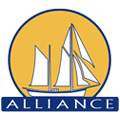
Sailing tours in the Calanques
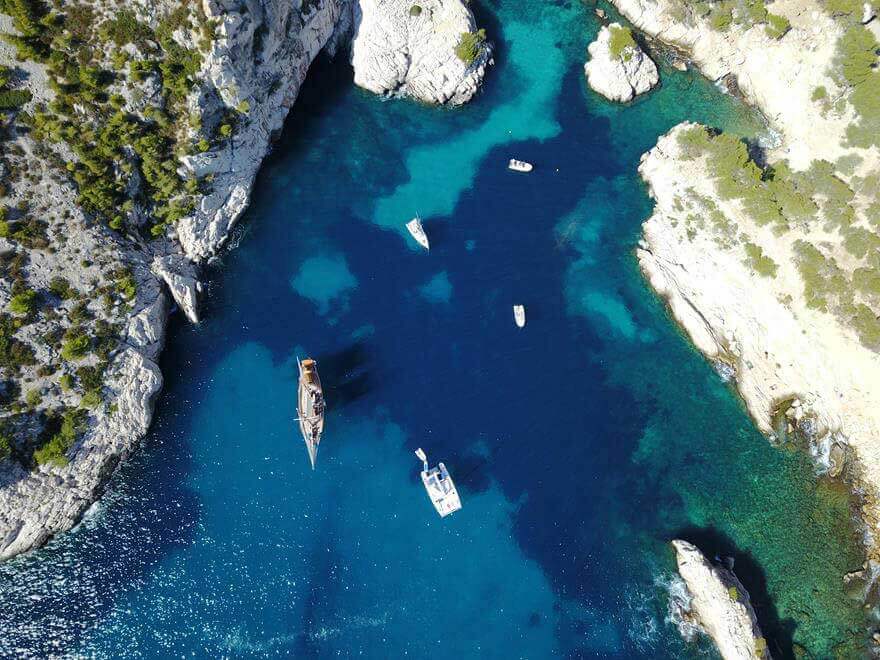
The Calanques of Marseille and Cassis
From the Vieux-Port, we sail South across the Bay of Marseille to the gates of the Calanques. La “Baie des Singes” (Bay of Monkeys) is an amazingly beautiful passage between Ile Maïre and Cap Croisette. We continue our tour in a natural setting, sailing pristine waters just like the first explorers, discovering new horizons.
Marseille’s calanques cover a 20-kilometer (12 mile) stretch of coastline between the village of Les Goudes, a community in the southwestern corner of Marseille, and Cassis. This is one of the most remarkable sites in France, and an important area for natural resources and sport activities. These Calanques are Schooner Alliance’s favorite terrain. In 2012, the Calanques massif became a National Park to which Alliance has privileged access. The setting is majestic, from the limestone cliffs overlooking untouched inlets, to the tiny fishing ports dotted with tiny “cabanons,” typical provençal houses.
Beyond the famous Grotte Cosquer (Cosquer cave) (today closed to the public), other marine caves are parts of our current itineraries, such as the Grotte Bleue and the Grotte du Capelan. The word “calanque” (from the Provençal “calanco”) is the word for a valley carved by a river before reaching the sea.
The numerous fossils encrusted in the limestone are evidence of a story that began more than one hundred million years ago with the accumulation of sediment in the seabed, followed by an uplifting during the Tertiary Period (when the Alps took shape). Erosion has accentuated the rifts and given birth to the rugged landscape we see today.
List of Calanques from West to East – Source Wikipédia: Calanque de Callelongue, Calanque de la Mounine, Calanque de Marseilleveyre, Calanque de Podestat, Calanque de l’Escu, Calanque de Sormiou, Calanque de la Triperie, Calanque de Morgiou, Calanque de Sugiton, Calanque du Devenson, Calanque de l’Oule, Calanque d’En-Vau, Calanque de Port-Pin, Calanque de Port-Miou
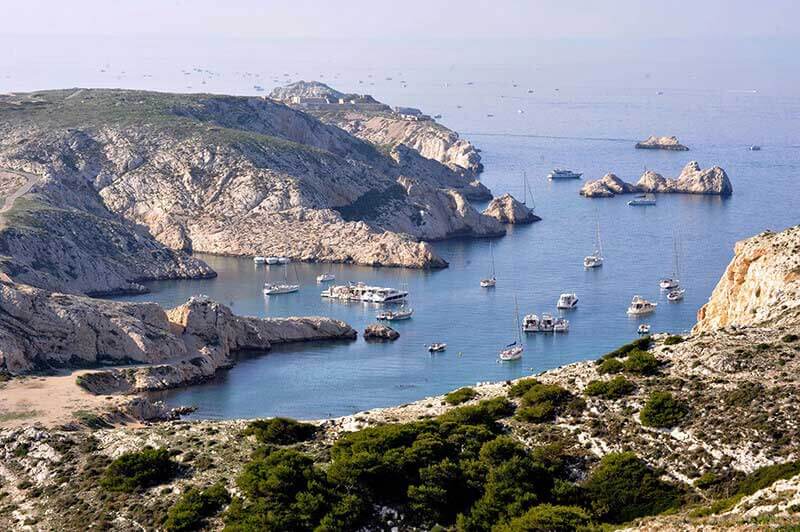
The Bay of Marseille and the Frioul Archipelago
From the villages of L’Estaque to Les Goudes, passing through the Frioul Archipelago. Pomègues, Ratonneau and Château d’If.
“To tell the truth, this is the only way to really love Marseille, by approaching from the sea. Early in the morning. When the sun emerges from behind the Marseilleveyre mountains to kiss the hillsides and wash the old stones in rosy light. That’s when you see the Marseille that Protis the Phocaean discovered.
And who cares if that’s an exaggeration? Marseille is always exaggerating.
It’s the city’s core. At its core, nothing has changed since that day. To reconnect with that story, all you have to do is arrive by ferry from Corsica. Or, easier still, come back from a night of fishing off the coast of l’Estaque. When the harbor opens its arms to you, then, and only then, you learn the immortal meaning of this city. Hospitality.”
Jean-Claude Izzo, Méditerranées
At the gates of Marseille, the four windswept limestone blocks of the Frioul Islands shelter the remains of their past: Pomègue and Ratonneau Islands were the mandatory quarantine stopover for all boats coming from Africa and Asia.
Château d’If, a beautiful fortress built on the orders of King Francis I, is world-famous thanks to Alexandre Dumas’ novel The Count of Monte Cristo.
Links to Marseille and the Bay of Marseille
– Sources Wikipedia: L’Archipel du Frioul, L’Île de Pomègues, L’Île de Ratonneau, Le Château d’If, L’Estaque, Le Vallon des Auffes, Les Goudes.
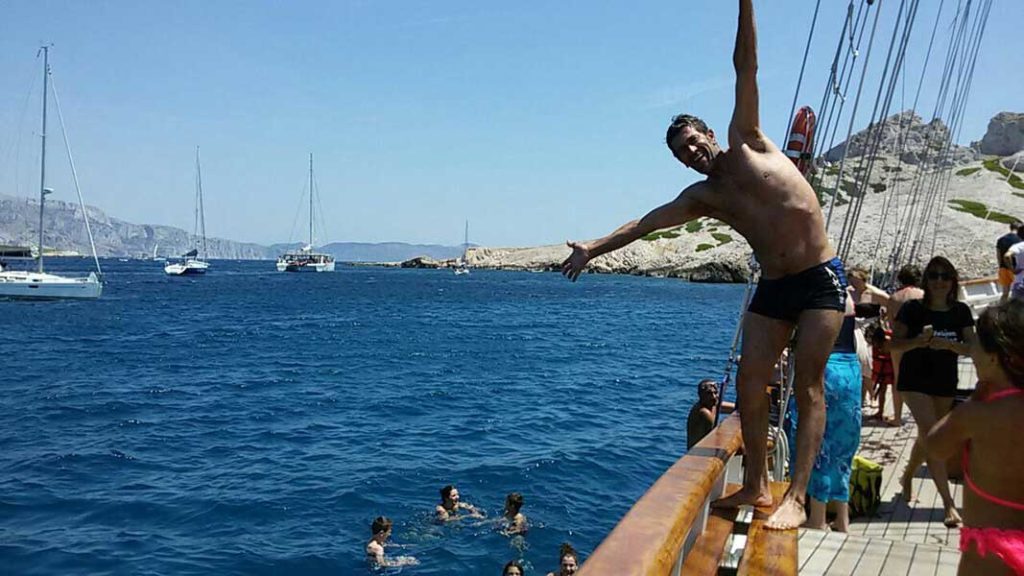
The Riou archipelago
An amazing site with an exceptional panoramic view of the entire Calanques massif, from île Maïre to Bec de l’Aigle.
We will bring you to an untouched landscape in a nature reserve reachable only by boat, setting anchorage in a privileged spot such as the calanques of Monasterio, Fontagne, or Pouars.
The National Park has set up “preservation zones” in this area where all types of fishing are forbidden. Today we can see the policy’s benefits: there are more and more fish, with bigger and more diversified specimens.
These islands are a real sanctuary for many rare species of animals and plants, and are a natural heritage site recognized at the European level.
The Riou Island is also called the Island of Birds (île aux oiseaux) because it plays a crucial role in the reproduction of such seabirds as the Cory’s shearwater, the Yelkouan shearwater, and the European storm petrel.
The archipelago is also an historical site for underwater archeology. Starting in 1952, Commander Cousteau and professor Fernand Benoît organized the first underwater exploration conducted from the surface. They discovered wrecks and shipments of Greek and Italic amphorae, the oldest of which date to the second century BC.
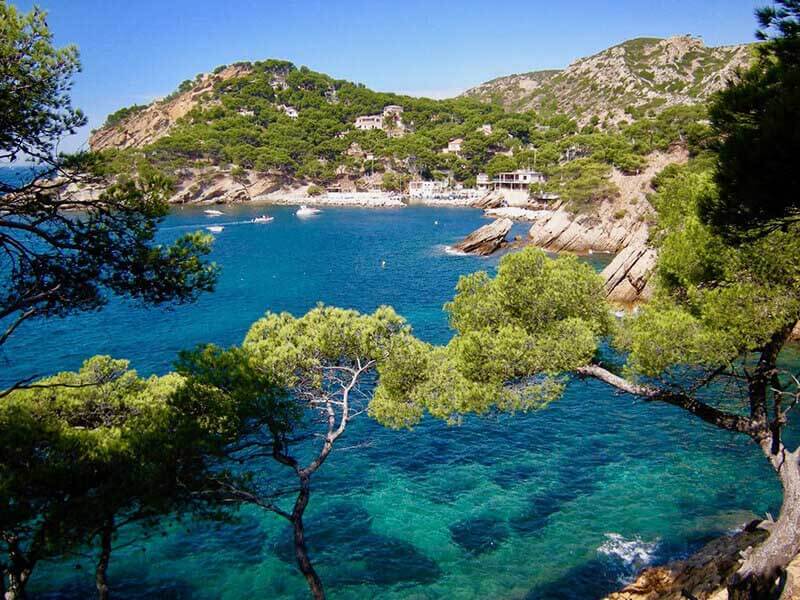
The Calanques of the Côte Bleue
The Côte Bleue, located West of Marseille, is the portion of the coastline going from l’Estaque to La Couronne. This “Blue Coast,” whose name refers to the color of the water surrounding the massif, is an ideal spot when the Mistral is blowing, as it is fairly well-protected from the wind.
The beaches are less frequented than those in the Calanques of Marseille and Cassis, and are not part of Calanques National Park. But people from Marseille love the West beaches as much as the East ones, and the luckiest have their own “cabanon.”
The Calanques of the Côte Bleue are loved by scuba diving enthusiasts, who don’t miss any of the famous “Oursinades” (Sea urchin feasts).
There are not many roads to the Côte Bleue and it can be difficult to get there: discovering it by sea is a better way to enjoy this beautiful coastline with outstanding vistas from the Bay of Marseille and the Frioul archipelago. The small fishing harbors of La Vesse, Niolon, Méjean, Figuières and La Redonne embody the spirit of the Calanques.
From Carry le Rouet to La Couronne, the coastline becomes less uneven and the seaside more oriented toward beach tourism. You will find the Côte Bleue’s most beautiful sandy beaches in La Couronne.
